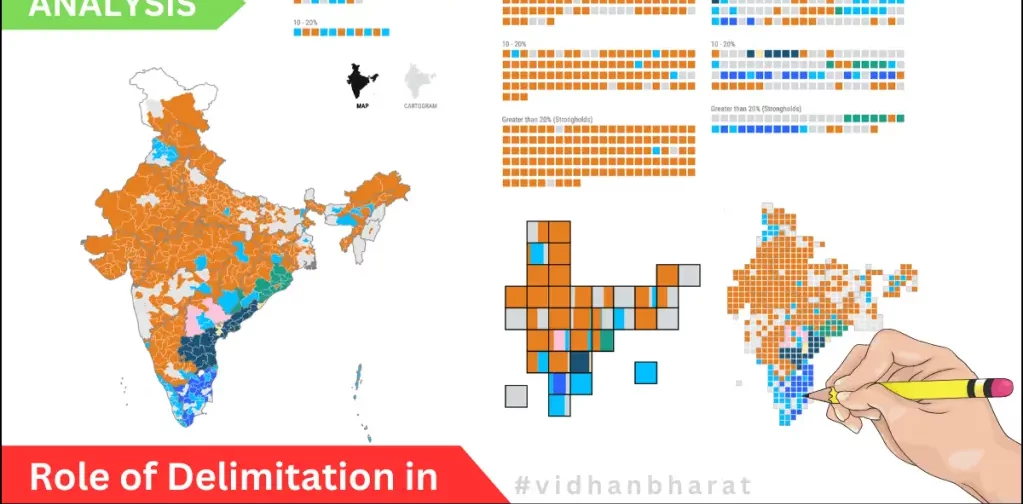
- Home
- About
- Knowledge Center
- Legislative Landscape
- Resources
- #TOGETHERFORBHARA
Delimitation, also known as redistricting or boundary redistribution, refers to the redrawing of electoral boundaries preventing malapportionment. By ensuring that each constituency has a roughly equal number of voters, delimitation helps to uphold the principle of one person, one vote.
As mandated in Article 82 of the Constitution of India, the distribution of Lok Sabha seats to the states shall be modified per the changes in population following each census. The process of delimitation thus seeks to balance the constituencies according to the strength of the electorate, thereby equating the votes cast by the electorate. Article 81, further, stipulates that the Lok Sabha can only have 550 members, with 530 coming from states and 20 from Union Territories and it also directs that for all states, the ratio between the number of seats and the population, as much as possible, be the same.
In India, the Delimitation Commission oversees the delimitation process and is in charge of establishing the boundaries or limits of India’s territorial constituencies. The Delimitation Commission consists of the Chief Election Commissioner, the State Election Commissioner, and a retired judge from either the Supreme Court or a Lower Court, appointed by the President of India. To redraw or create new constituencies, the Commission looks at demographic trends in consultation with State Election Commissions. It then makes its draft report which is published in the official Gazette. After considering relevant public comments, the Commission releases its final report. The Delimitation Commission’s orders are final and indisputably enforceable and thus cannot be legally contested. The copies of its reports are eventually presented to the relevant State Legislative Assembly and Lok Sabha for their perusal.
As a country that has evolved politically, the delimitation laws in India have undergone drastic changes over the years. The first comprehensive delimitation exercise took place in 1952, following India’s first general elections. These commissions have been previously established four times: in 1952, in 1963, in 1973, and 2002. 1 During the national emergency period (1975-1977), the Congress government led by Indira Gandhi, with the 42nd Amendment to the Constitution (which took effect in 1976) deferred delimitation until the 2001 Census under Article 82 and froze the number of Lok Sabha seats. The suspension was due to “family planning policies,” stating that they did not want to penalize states that had effective population control measures because their representation in the Lok Sabha would decline relative to states with larger populations. 2 However, the 84th Amendment, passed in 2002 during the BJP government led by Atal Bihari Vajpayee, postponed delimitation for a further period of 25 years, which tallied the total period of deferment to 50 years. Apparently, Article 82 which formed the basis for seat distribution was put on hold by the Amendment until “the relevant figures for the first Census taken after the year 2026 have been published.”
The process of delimitation in the states of Assam, Arunachal Pradesh, Nagaland, and Manipur, was postponed separately owing to “security concerns”. In the year 2020, a reconstituted Delimitation Commission was tasked with examining Jammu and Kashmir, following its division into two Union Territories in 2019. The next delimitation would typically have taken place following the 2031 Census. However, the Covid-19 pandemic caused a delay in the 2021 Census. The Union Government has said that the Census will start shortly after the 2024 Lok Sabha elections. Apparently, the Women’s Reservation Bill, which was a breakthrough for the Narendra Modi government is said to be enacted upon completion of delimitation exercise, meaning that the process will also identify the constituencies that are exclusively designated for female candidates.
Interestingly, advancements in technology have revolutionized the way boundaries are redrawn, making the process more efficient, transparent, and accurate. One of the key areas where technology has had a significant impact is data analysis. By utilizing sophisticated software and algorithms, delimitation commissions can analyze vast amounts of demographic and geographic data to identify the most appropriate boundaries. This data-driven approach ensures that redrawing boundaries is based on objective criteria, rather than subjective judgments or political motivations.
On the same line, a global analytical viewpoint on delimitation attracts a case study on South Africa, which implemented a delimitation process after the end of apartheid. Through the use of technology and data-driven analysis, the IEC (Independent Electoral Commission) was able to create constituencies that reflected the country’s diverse demographics. Similarly, in New Zealand, the delimitation Commission considers not only population but also factors such as community interests, geographic features, and the preservation of recognizable communities within electorates. These case studies demonstrate that by adopting innovative approaches, using technology, involving independent bodies, and considering multiple factors for redrawing boundaries, countries can achieve more inclusive and representative democracies.
To conclude, there are presently significant differences between states regarding the typical number of electors represented by each MP because the overall number of Lok Sabha seats has been static for nearly 50 years. The goal of the 2026 delimitation process would probably be to distribute seats such that the population of each parliamentary constituency is around the same. This would result in more seats being allocated to states with large populations. With the adoption of innovative technological solutions, India can modernize its delimitation practices by embracing technology, making them more accurate, transparent, and participatory.
